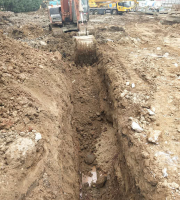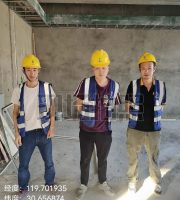2.
When constructing the post-cast strip, the number and position of the post-cast strip must be determined in combination with the actual situation of the construction project, so as to improve the strength of the overall structure.
Various factors shall be considered during setting.
Finally, certain admixtures can also be added to the overall structure to play a moisturizing effect and reduce the generation of hydration heat.
Prevention and control measures for settlement cracks The settlement of aggregate particles and the obstruction of the cement slurry floating process will lead to the formation of settlement cracks.
Reinforced concrete is the main material used in urban construction.
Therefore, during the construction process, the construction personnel should reduce the location of placement and blanking, strictly control the thickness of the protective layer of reinforcement, master the time and intensity of vibration, so as to achieve full vibration.
It is necessary to conduct in-depth analysis on the causes of cracks, select targeted control measures for different types of cracks, do a good job of prevention during construction, ensure standardized operation, and reduce the probability of construction cracks.
5.
After the crack prevention and control concrete configuration during the construction of reinforced concrete is completed, during the mixing process, it is necessary to ensure the uniformity of speed, operate according to relevant standards, control the mixing time, and improve the application performance of concrete materials.
In addition, the time interval of layered vibration should not be too long.
Prevention and control measures for materials The quality of materials is one of the main factors affecting the overall quality of the construction project.
During transportation, mixing cannot be stopped to keep the concrete materials in good condition and avoid segregation, otherwise it will affect the construction quality and easily cause cracks.
The prevention and control measures for temperature cracks should first be controlled from the selection of materials, determine the type of cement materials, reduce the generation of temperature stress, and prevent the occurrence of cracks from the source.
In order to reduce the impact on building quality, effective prevention and control of cracks are required.
At the same time, it is also necessary to consider the settlement of the building structure, reasonably control the depth of the foundation construction, and avoid the phenomenon of uneven settlement.
6.
In the mixing process, the amount of cement and water can be reduced and the application performance of the mixture can be improved on the premise of ensuring the quality of the mixture.
The location and size of construction joints shall be well designed, and expansion joints shall be set according to the construction needs and specific design standards.
The development process of the city is accelerating, and the number of construction projects is also increasing.
During the construction of soft soil foundation, the properties of the materials used should be consistent, and the settlement of the structure should be controlled to avoid damaging cracks caused by uneven settlement.
Before the reinforced concrete construction, it is necessary to analyze the stress condition of the concrete components, clarify the relationship between the forces borne by the reinforced concrete structure in application, and determine the bearing capacity of the reinforced concrete.
At the same time, it is also necessary to scientifically control the moisture content in the mixture.
Through reasonable control of the internal temperature of concrete components, the generation of temperature cracks can be reduced and the quality of reinforced concrete components can be guaranteed.
The construction unit must pay more attention to the prevention and control of cracks, understand the harm to the whole building when the cracks are serious, do a good job in the construction quality control of all links, carry out the construction of reinforced concrete in accordance with relevant standards, and avoid the occurrence of cracks while playing the role of reinforced concrete materials.
At the same time, it is also necessary to avoid the influence of external factors on the concrete quality and achieve effective prevention and control of cracks.
Scientific reinforcement and increase reinforcement ratio are important methods to avoid structural mutation.
Secondly, in order to coordinate the hydration heat reaction of cement, an appropriate amount of fly ash can be added into the material to control the temperature.
After pouring, attention must be paid to the curing of concrete, and the temperature and humidity of concrete materials must be controlled.
If the reinforced concrete structure changes, or the width of the expansion joint increases, and there is a certain deviation from the design standard, it is necessary to formulate anti-crack measures to prevent the crack problem through reinforcement construction, post-cast belt construction, and optimization of concrete grading.
Through scientific design of reinforcement, the anti-crack ability of the overall structure can be improved.
There are many cracks in reinforced concrete materials, which affect the function of the building.
Cement is prone to hydration heat reaction during mixing, so cement materials with small hydration heat reaction shall be selected as far as possible to reduce the degree of hydration heat during concrete solidification.
Through the reasonable configuration of the material, it is conducive to effective control of temperature, stress and other factors and reduce the formation of cracks.
It is easy to produce cracks of different degrees under the influence of temperature, stress and load, which has an important impact on the quality and stability of the building structure.
An appropriate amount of water-reducing agent can be added to ensure the application effect of the material and prevent the formation of cracks.
During the development of the industry, the crack problem has always been a problem that the relevant departments pay more attention to and urgently need to solve.
Before pouring concrete, the reinforcement and formwork shall be soaked to reduce the temperature of the reinforcement and formwork.
In the process of pouring, the layered pouring method is generally adopted, pouring is carried out in sequence, and the position of construction joint is determined, considering the overall construction structure.
3.
4.
Ensure that the construction design is scientific and reasonable.
Building cracks are common problems in engineering construction, and there are many factors that lead to this problem.
Conclusion For the crack problem in the construction of reinforced concrete buildings, it is necessary to consider the influence factors from various aspects, and crack prevention and control work should be done well in each link of construction.
.
1.
The following is the prevention and control measures for cracks in reinforced concrete construction.
It is necessary to strictly control the quality of materials, determine the amount of each material when configuring the mixture, and ensure the rationality of the proportion.
A protective film can be covered on the concrete surface to avoid excessive temperature difference between the inside and outside.



